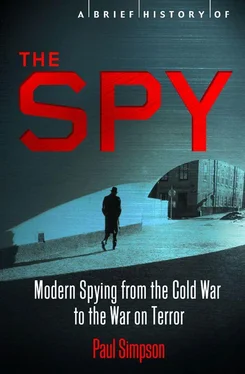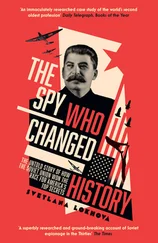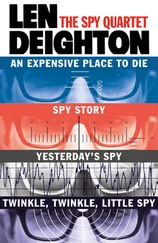Paul Simpson - A Brief History of the Spy
Здесь есть возможность читать онлайн «Paul Simpson - A Brief History of the Spy» весь текст электронной книги совершенно бесплатно (целиком полную версию без сокращений). В некоторых случаях можно слушать аудио, скачать через торрент в формате fb2 и присутствует краткое содержание. Город: London, Год выпуска: 2013, ISBN: 2013, Издательство: Constable & Robinson, Жанр: Прочая документальная литература, на английском языке. Описание произведения, (предисловие) а так же отзывы посетителей доступны на портале библиотеки ЛибКат.
- Название:A Brief History of the Spy
- Автор:
- Издательство:Constable & Robinson
- Жанр:
- Год:2013
- Город:London
- ISBN:9781780338910
- Рейтинг книги:3 / 5. Голосов: 1
-
Избранное:Добавить в избранное
- Отзывы:
-
Ваша оценка:
- 60
- 1
- 2
- 3
- 4
- 5
A Brief History of the Spy: краткое содержание, описание и аннотация
Предлагаем к чтению аннотацию, описание, краткое содержание или предисловие (зависит от того, что написал сам автор книги «A Brief History of the Spy»). Если вы не нашли необходимую информацию о книге — напишите в комментариях, мы постараемся отыскать её.
A Brief History of the Spy — читать онлайн бесплатно полную книгу (весь текст) целиком
Ниже представлен текст книги, разбитый по страницам. Система сохранения места последней прочитанной страницы, позволяет с удобством читать онлайн бесплатно книгу «A Brief History of the Spy», без необходимости каждый раз заново искать на чём Вы остановились. Поставьте закладку, и сможете в любой момент перейти на страницу, на которой закончили чтение.
Интервал:
Закладка:
While Aldrich Ames was a useful asset for the Soviets within the CIA, the other recruit who joined the KGB during the tail end of 1985 would prove to be one of their best agents, giving them access to the FBI’s counter-intelligence efforts periodically between then and his capture in 2001. Robert Philip Hanssen was described by David Major, the former director of counter-intelligence at the US National Security Council and Hanssen’s direct superior from 1987 onwards, as ‘diabolically brilliant… He knew everything we knew about what the Soviets did — and we knew a lot about how they operated. He also knew what we did. So he could operate within the cracks.’
Hanssen joined the FBI in 1976, and three years later was assigned to the New York field office helping to create an automatic database to track Soviet intelligence officers — and promptly became one himself, volunteering his services to the GRU via their front organization, AMTORG. In return for cash, he provided the Soviets with information regarding Dmitiri Polyakov’s espionage activities for the CIA (which the GRU chose to ignore), as well as a list of Soviets that the FBI suspected were spies in the US.
His work for the GRU came to an end in 1981 after he was caught by his wife writing to the Soviets; he confessed to his priest, and passed the monies the GRU had given him to charity. Hanssen was transferred to Washington that year, where he headed up a unit analysing the FBI’s data on Soviet activities, and coordinating projects against them.
Hanssen returned to New York in 1985 as supervisor in counter-intelligence, operating against the Soviet mission at the UN, as well as the consulate. Ten days after his arrival in the Big Apple, he wrote to Victor Degtyar, a middle-level intelligence officer at the Washington residency. He enclosed a letter for KGB resident Victor Cherkashin, in which he asked for $100,000 for a box of documents of classified and top-secret material that would shortly be delivered to Degtyar’s private address, and revealing the names of three spies (all of whom, although he was unaware of it at the time, had already been betrayed by Aldrich Ames). When Cherkashin received the promised documents, they showed how valuable this anonymous spy would be.
Because he knew so much about both American and Soviet tradecraft, Robert Hanssen wasn’t prepared to fall in line with the usual KGB methodology regarding dead drops and rendezvous. He dictated how they would be handled, operating, as David Major noted, ‘within the cracks’. He made the KGB come to dead drops near his own home so that their actions were minimised — as Cherkashin admiringly notes in his autobiography, ‘All we had to do was drop our package and make a signal.’ He also refused to reveal his identity — the first time Cherkashin knew Hanssen’s name was when he was arrested in 2001.
Money didn’t seem to be his underlying motive (although he would tell his interrogators something different after his capture); Cherkashin considered that Hanssen liked showing off his expertise, and ‘was either unhappy with his job or simply bored’. He certainly didn’t see this — at that stage at least — as a long-term arrangement: ‘Eventually, I would appreciate an escape plan. (Nothing lasts forever.)’, Hanssen wrote shortly after making contact. Hanssen deliberately avoided communication with Cherkashin through the spring and early summer of 1986 after becoming overly suspicious of a mention of the KGB resident in a defector’s debriefing, and dropped in and out of contact over the next fifteen years. It would be a long time before he might need an escape plan. As it transpired, Robert Hanssen was only five weeks away from retirement when he was eventually caught.
12
THE LONG TWILIGHT STRUGGLE
In June 1985, President Ronald Reagan told the American people that they were ‘in a long twilight struggle with an implacable foe of freedom’. Very few people would have predicted at the end of The Year of the Spy that within six years the KGB would be no more, the Cold War would be over, and the intelligence services of the West would find their future role under discussion.
During the late eighties, the KGB continued its policy of misinformation, planting propaganda stories that would influence other countries’ views of America and the CIA. The CIA’s involvement in the Iran — Contra affair suggested that the dark times of the sixties might be returning. The game of Spy vs Spy seemed to be at its height, with the trade-offs of the Daniloff affair equivalent to some of the ill-matched spy swaps of the earlier decades. But Mikhail Gorbachev’s reforms — coupled with some genuine accidents, such as the one that led to the end of the Berlin Wall — meant that the era of the Soviet Union’s domination of Eastern Europe was drawing to a close.
Spreading lies and disinformation about the Main Enemy was not a new tactic for the KGB; through front organizations and receptive writers, they had propagated many false theories over the years, such as Soviet agent Joachim Joesten’s book Oswald: Assassin or Fall-Guy , published in 1964 about the assassination of John F. Kennedy. In 1982 Moscow Centre had tried to discredit the US Ambassador to the United Nations, Jeane Kirkpatrick, with a story planted in the British New Statesman magazine which suggested strong ties between her and the then-pariah South African regime (although the documents backing this up hadn’t been checked properly — the spelling of the word ‘priviously’ ( sic ) was a giveaway.) This was written by journalist Claudia Wright, who would later push other Soviet propaganda lines, such as her statement in the Dublin Sunday Tribune in 1989 that KAL 007 ‘the Korean Airlines jumbo jet, shot down by the Soviet Air Force six years ago today, was on a spy mission for the US’.
These operations, known as ‘active measures’, became more prevalent in the late eighties, despite Chairman Gorbachev’s claim in July 1987 that ‘We tell the truth and nothing but the truth.’ In one of Yuri Andropov’s last decrees as Chairman of the KGB in 1982, he stated that it was the duty of all foreign intelligence officers, no matter which department they were part of, to participate in active measures. It was an area that was often ‘sub-contracted’ to satellite states, such as East Germany. As Colonel Rolf Wagenbreth, director of Department X (disinformation) of East German foreign intelligence, once said, ‘Our friends in Moscow call it ‘‘dezinformatsiya’’. Our enemies in America call it ‘‘active measures’’, and I, dear friends, call it ‘‘my favourite pastime’’.’
After attempts were made to blacken the name of Polish Solidarity leader Lech Walesa before he was awarded the Nobel Peace Prize in 1983, Pope John Paul II, himself a Pole, came under attack. The KGB had been treating him as an enemy since 1971 for his anti-Communist tendencies, and in December 1984 they began further measures designed to tar him as a reactionary. President Reagan’s speech to the European Parliament in May 1985 was heckled as an active measure. Forged letters were used to bolster the impression of an out-of-control American government: CIA director William Casey apparently planned to overthrow Indian prime minister Rajiv Gandhi in 1987; in January 1988 documents suggested President Reagan gave instructions to the NSA to destabilize Panama. South African Foreign Minister Pik Botha referred to a secret and sinister agreement with the US in a letter he supposedly sent in 1989.
The most potentially damaging active measures were stories about medical experiments carried out by the Americans. The story that the Aids virus was manufactured during a genetic engineering experiment at Fort Detrick, which had been the home of the US biological weapons’ programme, first appeared in a pro-Soviet Indian newspaper, Patriot , in 1983, but was really ignored until it was magnified in the Russian Literaturnaya Gazeta in October 1985. This new version was then followed by a report from a retired East German biophysicist (and Stasi informant), Professor Jacob Segal, which ‘demonstrated’ that the virus had been artificially synthesized. Segal genuinely believed his theory, despite it being discredited, and pushed it until his death in 1995. His hypothesis was reported as fact by British newspapers the Sunday Express and the Daily Telegraph the following year, and indeed continues to be quoted to this day by conspiracy theorists.
Читать дальшеИнтервал:
Закладка:
Похожие книги на «A Brief History of the Spy»
Представляем Вашему вниманию похожие книги на «A Brief History of the Spy» списком для выбора. Мы отобрали схожую по названию и смыслу литературу в надежде предоставить читателям больше вариантов отыскать новые, интересные, ещё непрочитанные произведения.
Обсуждение, отзывы о книге «A Brief History of the Spy» и просто собственные мнения читателей. Оставьте ваши комментарии, напишите, что Вы думаете о произведении, его смысле или главных героях. Укажите что конкретно понравилось, а что нет, и почему Вы так считаете.












